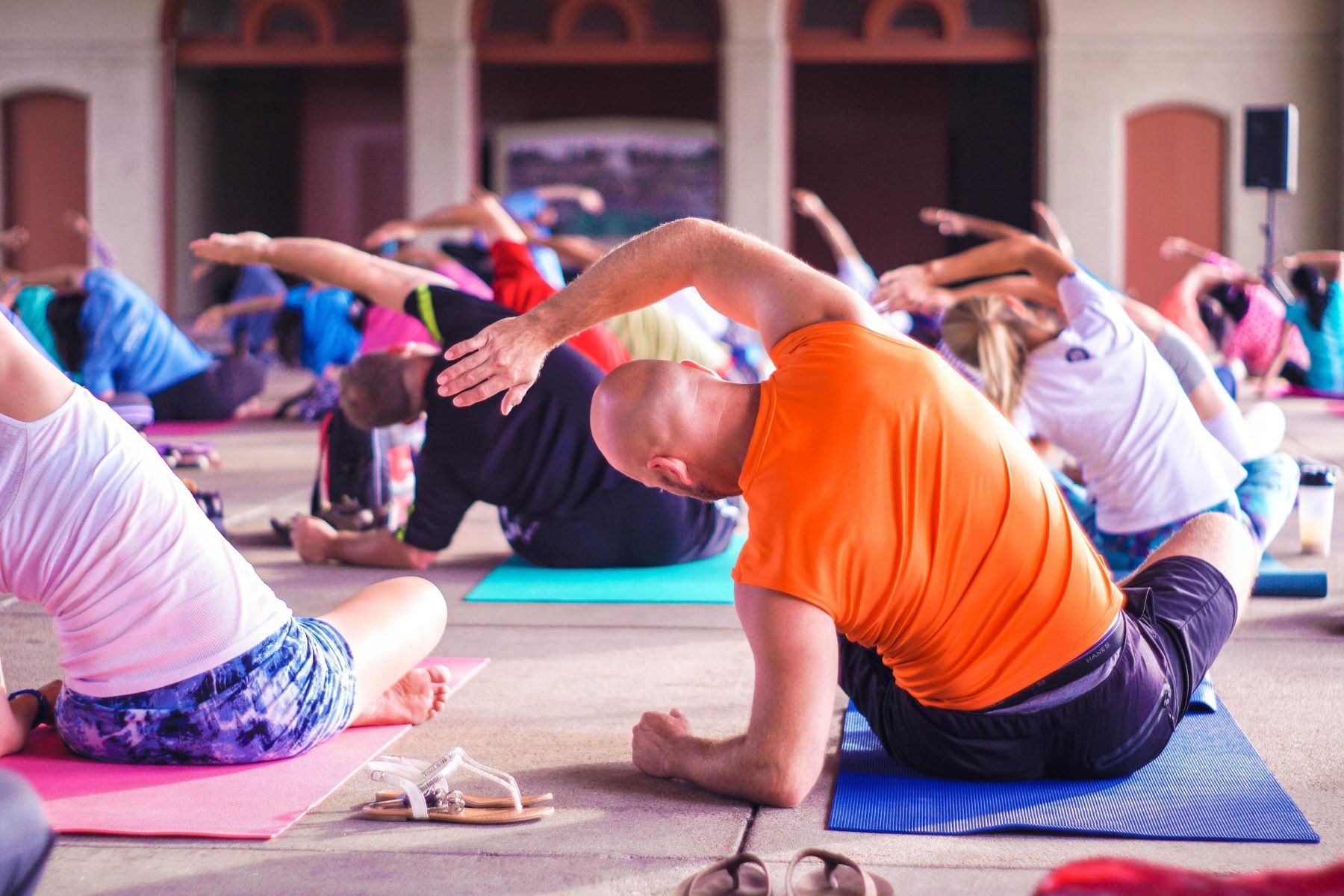

Featured
What Is Cardiorespiratory Endurance
Modified: January 22, 2024
Discover the importance of cardiorespiratory endurance and how it enhances overall fitness. Get featured tips, workouts, and expert advice to boost your stamina.
Overview
Cardiorespiratory endurance, also known as cardiovascular endurance or aerobic fitness, refers to the ability of the heart, lungs, and muscles to work together efficiently and supply oxygen-rich blood to the body during prolonged physical activity. It is a crucial component of overall fitness and plays a vital role in maintaining optimal health and wellbeing.
Having good cardiorespiratory endurance is essential for performing daily activities, such as climbing stairs, chasing after kids, or participating in sports and recreational activities. It allows you to engage in sustained physical exertion without experiencing excessive fatigue or breathlessness.
Improving cardiorespiratory endurance offers a wide range of benefits, not only for athletes and fitness enthusiasts but for everyone, regardless of age or fitness level. Regular aerobic exercise not only strengthens the heart and lungs but also helps manage weight, reduce the risk of chronic diseases, improve mental health, and boost overall energy levels.
There are several factors that can influence cardiorespiratory endurance, including genetics, age, gender, body composition, and lifestyle habits. While some of these factors are beyond our control, there are various techniques and strategies that can be implemented to enhance and maintain cardiorespiratory fitness.
In this article, we will explore the importance of cardiorespiratory endurance and the various factors that can impact it. We will also provide tips and techniques to improve cardiorespiratory endurance, suggest effective workouts, and discuss methods for testing and monitoring your progress. By understanding the significance of cardiorespiratory endurance and implementing proper training methods, you can enhance your fitness level and improve your overall quality of life.
Definition
Cardiorespiratory endurance, often referred to as cardiovascular endurance or aerobic fitness, is a measure of how efficiently the heart, lungs, and muscles work together to supply oxygen-rich blood to the body during sustained physical activity. It is an important aspect of overall fitness and is closely related to the body’s ability to perform tasks that require extended periods of physical exertion.
This endurance is primarily dependent on the efficiency of the cardiovascular system (heart and blood vessels) in delivering oxygenated blood to the working muscles. The oxygen is then used by the muscles to produce energy, allowing them to sustain activity over a prolonged time period.
Cardiorespiratory endurance can be assessed by measuring the body’s maximum oxygen uptake, also known as VO2 max. This measurement indicates the maximum amount of oxygen that can be consumed and used by the body during exercise. The higher the VO2 max, the greater the individual’s cardiorespiratory endurance.
It’s important to note that cardiorespiratory endurance is different from muscular endurance, which focuses on the ability of muscles to perform repetitive actions or resist fatigue.
Improving cardiorespiratory endurance involves engaging in aerobic activities that elevate the heart rate and challenge the cardiovascular system. These activities can include running, cycling, swimming, brisk walking, dancing, and various other forms of aerobic exercise.
Regular participation in aerobic exercise stimulates adaptations in the cardiovascular system, such as increased stroke volume (the amount of blood pumped per heartbeat), improved blood vessel dilation, and enhanced oxygen utilization by the muscles. These adaptations result in improved cardiorespiratory endurance and allow individuals to better withstand prolonged physical activity without experiencing excessive fatigue or breathlessness.
By increasing cardiorespiratory endurance, individuals can improve their overall health, enhance their ability to perform daily tasks, and participate in physical activities with greater stamina and efficiency. It is an essential component of overall fitness and is crucial for maintaining optimal health and wellbeing.
Importance
Cardiorespiratory endurance plays a critical role in maintaining optimal health and wellbeing. Here are some key reasons why improving and maintaining cardiorespiratory endurance is important:
- Enhanced Physical Performance: Good cardiorespiratory endurance allows individuals to perform physical activities more efficiently and with less fatigue. Whether it’s running a marathon, playing a game of basketball, or simply keeping up with daily chores, having a strong cardiovascular system enables individuals to sustain physical exertion for longer periods without feeling exhausted.
- Reduced Risk of Chronic Diseases: Regular aerobic exercise and improved cardiorespiratory endurance have been linked to a lower risk of developing chronic conditions such as heart disease, high blood pressure, stroke, obesity, type 2 diabetes, and certain types of cancer. Engaging in moderate to intense aerobic activity on a regular basis can help manage weight, improve insulin sensitivity, regulate blood pressure, and promote overall cardiovascular health.
- Weight Management: Aerobic exercise is an effective tool for weight management. Engaging in activities that increase heart rate and burn calories can contribute to a negative energy balance, leading to weight loss or maintenance. Additionally, regular aerobic exercise can help boost metabolism, increase lean muscle mass, and improve body composition.
- Improved Mental Health: Regular aerobic exercise has been linked to improved mental health, including reduced symptoms of depression, anxiety, and stress. Physical activity stimulates the release of endorphins, neurotransmitters that are known to boost mood and improve overall mental wellbeing. Additionally, exercise provides a sense of accomplishment and self-confidence, improving self-esteem and reducing the risk of mental health disorders.
- Increased Energy Levels: Regular aerobic activity improves the efficiency of the cardiovascular system, allowing the body to deliver oxygen and nutrients more effectively to the muscles and organs. This increased delivery of oxygen and nutrients helps to enhance energy production in the body, leading to improved energy levels and reduced feelings of fatigue and lethargy.
Overall, cardiorespiratory endurance is vital for maintaining physical health, preventing chronic diseases, managing weight, promoting mental wellbeing, and increasing energy levels. By incorporating regular aerobic exercise into your routine and improving your cardiorespiratory fitness, you can experience these numerous benefits and enhance your overall quality of life.
Factors Affecting Cardiorespiratory Endurance
Cardiorespiratory endurance is influenced by various factors, both intrinsic and extrinsic, that can affect an individual’s ability to perform sustained physical activity. Understanding these factors can help individuals identify areas for improvement and implement strategies to enhance their cardiorespiratory fitness. Here are some key factors that can impact cardiorespiratory endurance:
- Genetics: Genetics play a role in determining an individual’s baseline cardiorespiratory endurance. Some individuals may naturally have a higher capacity for aerobic exercise due to genetic factors such as their muscle fiber composition, lung capacity, and heart size and efficiency.
- Age: Cardiovascular fitness tends to decline with age. As we get older, there is a gradual decrease in the maximum heart rate and a reduction in the body’s ability to deliver oxygen to the muscles. However, regular aerobic exercise can help slow down this decline and maintain cardiovascular health.
- Gender: On average, men tend to have a higher cardiorespiratory endurance capacity compared to women. This is partly due to differences in body composition, hormones, and hemoglobin levels. However, it’s important to note that there is significant individual variation within genders, and both men and women can improve their cardiorespiratory fitness with proper training.
- Body Composition: Body composition, specifically the percentage of body fat and lean muscle mass, can impact cardiorespiratory endurance. Excess body fat can strain the cardiovascular system, while a higher muscle mass improves energy utilization and oxygen delivery to the muscles.
- Lifestyle Habits: Factors such as physical activity levels, sedentary behavior, and smoking can greatly influence cardiorespiratory endurance. Regular aerobic exercise helps improve cardiovascular fitness, while a sedentary lifestyle can negatively impact heart and lung health. Smoking, on the other hand, damages lung function and reduces oxygen-carrying capacity.
- Training and Exercise History: Individuals with a consistent history of aerobic exercise tend to have better cardiorespiratory endurance. Regular training helps improve the efficiency of the cardiovascular system, leading to increased oxygen uptake and utilization by the muscles.
- Environmental Factors: Environmental conditions such as altitude, temperature, and humidity can affect cardiorespiratory endurance. Higher altitudes reduce oxygen availability, making physical activity more challenging. Extreme temperatures and humidity can also impact the body’s ability to regulate temperature and may increase the strain on the cardiovascular system.
While some factors, such as genetics and age, are beyond our control, it’s important to focus on the factors that can be modified. By adopting a healthy lifestyle, engaging in regular aerobic exercise, and implementing proper training techniques, individuals can improve their cardiorespiratory endurance and overcome genetic predispositions or age-related decline. Assessing these factors and making adjustments to optimize cardiorespiratory fitness can lead to better overall health and performance.
Benefits of Improving Cardiorespiratory Endurance
Improving cardiorespiratory endurance offers a wide range of benefits for individuals of all ages and fitness levels. By engaging in regular aerobic exercise and enhancing cardiovascular fitness, you can experience the following advantages:
- Improved Heart and Lung Health: Regular aerobic exercise strengthens the heart muscle, increasing its efficiency to pump blood and oxygen to the rest of the body. It also improves lung capacity and enhances the body’s ability to take in and utilize oxygen, leading to better overall heart and lung health.
- Increased Energy Levels: Enhanced cardiorespiratory endurance improves the body’s ability to produce energy and deliver it to the muscles efficiently. This leads to increased energy levels throughout the day, reduced feelings of fatigue, and improved stamina for daily tasks and physical activities.
- Weight Management: Aerobic exercise plays a significant role in weight management. Regular participation in activities that elevate the heart rate and burn calories can contribute to calorie expenditure and create a calorie deficit, leading to weight loss or maintenance. Combined with a balanced diet, improved cardiorespiratory endurance can help control body weight and composition.
- Reduced Risk of Chronic Diseases: Maintaining good cardiorespiratory endurance reduces the risk of chronic conditions, including cardiovascular diseases, high blood pressure, obesity, type 2 diabetes, and certain types of cancer. Regular aerobic exercise helps lower blood pressure, improve blood lipid profiles, regulate blood sugar levels, and reduce the risk of developing these long-term health conditions.
- Enhanced Mental Wellbeing: Engaging in aerobic exercise has been shown to have positive effects on mental health. Regular cardiovascular workouts release endorphins, known as “feel-good” hormones, which reduce anxiety, stress, and symptoms of depression. Exercise also improves cognitive function, memory, and overall mental wellbeing, promoting a positive mindset.
- Improved Sleep Quality: Regular physical activity, including aerobic exercise, can enhance sleep quality. It helps regulate the sleep-wake cycle, improves the ability to fall asleep faster, and promotes deeper, more restful sleep. Better sleep contributes to improved overall health, mood, and cognitive function.
- Enhanced Performance in Physical Activities: Improved cardiorespiratory endurance enhances performance in various physical activities, ranging from recreational sports to daily tasks. Whether it’s running, cycling, swimming, or simply keeping up with household chores, greater cardiovascular fitness allows you to perform activities with increased stamina, efficiency, and reduced fatigue.
By working on your cardiorespiratory endurance, you can enjoy these numerous benefits and improve your overall health, fitness, and quality of life. Remember that consistency is key, and it’s important to gradually increase the duration and intensity of your aerobic exercise to continue challenging your cardiovascular system and reaping the rewards it brings.
Techniques to Improve Cardiorespiratory Endurance
Improving cardiorespiratory endurance requires consistent effort and a combination of different training techniques. Here are some effective strategies to enhance your cardiovascular fitness:
- Aerobic Exercise: Engage in regular aerobic activities that elevate your heart rate and challenge your cardiovascular system. This includes activities such as running, cycling, swimming, brisk walking, dancing, and group fitness classes. Aim for at least 150 minutes of moderate-intensity aerobic exercise or 75 minutes of vigorous-intensity exercise per week.
- Interval Training: Incorporate interval training into your aerobic workouts. Alternate between periods of high-intensity exercise and active recovery or lower-intensity exercise. For example, sprint for 30 seconds, followed by 1 minute of jogging or walking. This type of training increases the intensity of your workouts and helps improve your endurance more rapidly.
- Progressive Overload: Gradually increase the duration, intensity, or frequency of your aerobic workouts over time. This principle of progressive overload challenges your cardiovascular system and allows for continuous improvement in cardiorespiratory endurance. Start with shorter, less intense workouts, and gradually increase the duration and intensity as your fitness improves.
- Cross-Training: Incorporate a variety of aerobic activities into your exercise routine to engage different muscle groups and challenge your cardiovascular system in different ways. This can also help prevent boredom and reduce the risk of overuse injuries. Mix activities like running, swimming, cycling, and aerobics classes to keep your workouts varied and engaging.
- Strength Training: Include regular strength training exercises to enhance muscular endurance and support cardiovascular fitness. Building lean muscle mass increases metabolism, improves energy utilization, and allows for better oxygen delivery to the muscles during aerobic exercise. Incorporate exercises that target major muscle groups, such as squats, lunges, push-ups, and rows.
- HIIT (High-Intensity Interval Training): HIIT workouts involve short bursts of intense exercise followed by brief recovery periods. These workouts are time-efficient and effective for improving cardiorespiratory endurance. Examples include Tabata training or circuit training, where you perform a series of exercises with minimal rest in between.
- Outdoor Activities: Take advantage of outdoor activities such as hiking, trail running, or cycling. Outdoor workouts not only provide a change of scenery but also introduce natural challenges like varying terrain and weather conditions, which can further enhance your cardiorespiratory fitness.
- Proper Nutrition and Hydration: Fuel your body with a balanced diet that includes adequate carbohydrates for energy, protein for muscle repair and growth, and healthy fats for overall health. Stay hydrated before, during, and after your workouts to optimize performance and recovery.
- Consistency and Progression: Consistency is key when striving to improve cardiorespiratory endurance. Make aerobic exercise a regular part of your routine and gradually increase the intensity or duration of your workouts to progress over time. Aim for at least 3-5 aerobic sessions per week.
Remember to listen to your body and rest when needed. Pushing yourself too hard without proper recovery can increase the risk of injury or overtraining. It’s also essential to consult with a healthcare professional before starting or significantly changing your exercise routine, especially if you have any underlying health conditions.
By implementing these techniques and maintaining consistency, you can effectively improve your cardiorespiratory endurance and enjoy the benefits of enhanced cardiovascular fitness.
Workouts for Increasing Cardiorespiratory Endurance
There are various workouts and exercise routines that are effective in improving cardiorespiratory endurance. Incorporating these workouts into your routine can help challenge your cardiovascular system, increase oxygen uptake, and enhance your overall fitness level. Here are some workouts to consider:
- Running: Running is a popular aerobic exercise that can be done outdoors or on a treadmill. Start with shorter distances and gradually increase your running time and intensity. You can also incorporate interval training, such as sprinting for a certain distance or time, followed by a period of recovery jogging or walking.
- Cycling: Cycling, whether on a stationary bike or outdoors, is a low-impact exercise that provides a great cardiovascular workout. You can adjust the resistance to increase intensity, and choose between shorter high-intensity rides or longer endurance rides to challenge your cardiorespiratory system.
- Swimming: Swimming is a total body workout that provides excellent cardiovascular benefits. The water’s resistance adds an additional challenge, while the low-impact nature of swimming reduces stress on the joints. Vary your strokes and intensity to target different muscle groups and improve your cardiorespiratory fitness.
- Jump Rope: Jumping rope is an effective and portable aerobic exercise that can be done almost anywhere. It provides a high-intensity workout that increases heart rate and challenges the cardiovascular system. Start with shorter intervals and gradually increase your jump rope sessions for improved endurance.
- Group Fitness Classes: Group fitness classes like Zumba, aerobic dance, kickboxing, or step aerobics provide a fun and energetic way to improve cardiorespiratory endurance. These classes often incorporate intervals, music, and motivational instructors to keep you engaged and push your limits.
- High-Intensity Interval Training (HIIT): HIIT workouts involve short bursts of intense exercise followed by brief recovery periods. This intense form of training helps improve cardiorespiratory endurance and can be done through activities like bodyweight exercises, kettlebell workouts, or sprint intervals.
- Circuit Training: Circuit training involves performing a series of exercises targeting different muscle groups with minimal rest in between. This type of workout not only challenges your cardiovascular system but also improves strength and muscular endurance. Combine exercises like burpees, jumping jacks, squats, push-ups, and lunges into a circuit for a full-body cardio workout.
- Stair Climbing: Climbing stairs is an excellent cardio workout that engages the lower body muscles and elevates heart rate. You can use stairs in your home or office building, or utilize stair climbing machines at the gym. Start with a few flights and gradually increase the duration or intensity of your stair climbing sessions.
- Elliptical Training: The elliptical machine provides a low-impact workout that simulates the motion of walking or running. By adjusting the resistance and incline, you can challenge your cardiovascular system while minimizing stress on the joints. Incorporate intervals or longer endurance sessions to improve cardiorespiratory endurance.
Remember to choose exercises or activities that you enjoy and that fit your fitness level. Vary your workouts to prevent boredom and maintain motivation, and gradually increase the intensity or duration over time to continually challenge your cardiorespiratory system. Consistency and progressive overload are key to improving cardiorespiratory endurance and achieving long-term fitness goals.
Testing Cardiorespiratory Endurance
Testing cardiorespiratory endurance is essential to assess your current fitness level, track progress, and set appropriate training goals. There are various tests that can be performed to evaluate your cardiovascular fitness. Here are some common methods used to test cardiorespiratory endurance:
- VO2 Max Test: The VO2 max test is considered the gold standard for measuring maximum aerobic capacity. It involves a graded exercise protocol on a treadmill or stationary bike while wearing a mask or using a mouthpiece to measure oxygen consumption and carbon dioxide production. This test provides an accurate measure of your cardiovascular fitness level.
- 1-Mile Walk Test: The 1-mile walk test is a simple and practical assessment of cardiorespiratory endurance. It involves walking a mile at a brisk pace, aiming to complete it as quickly as possible. The time taken to complete the mile is used as an indicator of fitness level, with faster times generally indicating better cardiorespiratory endurance.
- Cooper Test: The Cooper test assesses aerobic endurance by measuring the distance covered in 12 minutes of continuous running or brisk walking. The farther you can travel within the time limit, the better your cardiorespiratory fitness. This test provides a quick estimate of your endurance capacity.
- Three-Minute Step Test: The three-minute step test measures your heart rate recovery after a set of stepping exercises. You step onto and off a step or bench for three consecutive minutes at a set pace. After the exercise, your heart rate is measured for one minute and then compared to age-specific norms to evaluate your cardiorespiratory fitness level.
- Maximal Stress Test: The maximal stress test, often performed on a treadmill or stationary bike, involves exercising at progressively increasing intensities until exhaustion. This test allows healthcare professionals to monitor your heart rate, blood pressure, and other physiological responses during exercise to assess cardiovascular health and endurance capacity.
- Field Tests: Field tests, such as the 6-Minute Walk Test or the 12-Minute Swim Test, provide a practical way to assess endurance in real-world situations. These tests involve performing a specified activity for a set duration, and the distance covered or completed is used as an indicator of cardiorespiratory endurance.
It’s important to note that these tests should be performed under the guidance of a healthcare professional or qualified fitness instructor to ensure safety and accurate assessment. They can provide valuable information about your current cardiorespiratory fitness level, help set realistic goals, and guide your training program. Regularly retesting can help monitor progress and make adjustments to your exercise routine accordingly.
Remember that testing cardiorespiratory endurance is just a snapshot of your fitness at a specific time. Other factors such as age, health conditions, and genetics can also influence your cardiorespiratory fitness. Therefore, it is important to interpret the results in the context of your overall health and fitness goals.
Tips for Maintaining Cardiorespiratory Endurance
Maintaining cardiorespiratory endurance is essential to sustain your fitness level and continue reaping the benefits of improved cardiovascular health. Here are some tips to help you maintain your cardiorespiratory endurance:
- Consistency: Stay consistent with your aerobic exercise routine. Aim to engage in at least 150 minutes of moderate-intensity aerobic activity or 75 minutes of vigorous-intensity aerobic activity each week, per the recommendations of the American Heart Association. Consistency is key to maintain and further improve your cardiorespiratory endurance.
- Varied Workouts: Diversify your workouts to prevent boredom and continuously challenge your cardiovascular system. Incorporate different aerobic activities like running, cycling, swimming, and group fitness classes in your routine. This helps engage different muscle groups and ensures a well-rounded cardiovascular workout.
- Progression: Gradually progress your workouts to maintain and continue improving your cardiorespiratory endurance. Increase the duration, intensity, or frequency of your exercise sessions over time, according to your fitness level and goals. Incorporate interval training, longer endurance sessions, or higher resistance to keep pushing your limits.
- Cross-Training: Engage in cross-training activities to enhance and maintain your cardiorespiratory fitness. Incorporate strength training exercises into your routine to improve muscular endurance and support cardiovascular health. This combination helps improve overall fitness and prevents overuse injuries.
- Active Lifestyle: Incorporate physical activity into your daily life whenever possible. Choose the stairs over elevators, walk or bike to nearby destinations instead of driving, and take active breaks throughout the day. These small lifestyle changes can contribute to maintaining your cardiorespiratory endurance.
- Monitor Intensity: Pay attention to your exercise intensity during aerobic workouts. Use methods such as the talk test – if you can comfortably carry on a conversation while exercising, you are likely working at a moderate intensity. If you can only speak a few words at a time, it indicates a higher intensity. Monitor your heart rate using a fitness tracker or monitor to ensure you are staying within your target heart rate zone.
- Proper Recovery: Allow your body to rest and recover adequately between workouts. Give yourself at least one or two days of rest or active recovery per week to help prevent overtraining and minimize the risk of injuries. Listen to your body and adjust your training intensity or volume accordingly.
- Healthy Lifestyle: Maintain a healthy lifestyle that supports cardiovascular health. Eat a balanced diet rich in fruits, vegetables, whole grains, lean proteins, and healthy fats. Stay hydrated, avoid smoking, limit alcohol consumption, and manage stress levels. These lifestyle factors contribute to overall cardiovascular health and support your cardiorespiratory endurance.
- Regular Testing: Periodically assess your cardiorespiratory endurance through testing to monitor your progress and adjust your training accordingly. This helps identify any changes or areas for improvement, allowing you to modify your workouts and maintain your fitness level.
By following these tips, you can effectively maintain your cardiorespiratory endurance and continue enjoying the numerous benefits of improved cardiovascular fitness over the long term.
Conclusion
Cardiorespiratory endurance is a vital component of overall fitness and plays a significant role in maintaining optimal health and wellbeing. By improving and maintaining cardiorespiratory endurance, individuals can enhance their physical performance, reduce the risk of chronic diseases, manage weight, improve mental wellbeing, and increase energy levels.
Factors such as genetics, age, body composition, and lifestyle habits can influence cardiorespiratory endurance, but many of these factors can be modified or improved through proper training and lifestyle choices. Engaging in regular aerobic exercise, incorporating interval training, and gradually increasing the intensity and duration of workouts are effective strategies to enhance cardiorespiratory fitness. Additional techniques such as cross-training, strength training, and monitoring exercise intensity can further optimize cardiovascular health.
Testing cardiorespiratory endurance allows individuals to assess their current fitness level, track progress, and set appropriate training goals. Methods such as VO2 max tests, 1-mile walk tests, and stress tests provide valuable insights into cardiovascular fitness and aid in determining areas for improvement.
To maintain cardiorespiratory endurance, consistency is key. Staying consistent with aerobic workouts, following a varied exercise routine, progressing workouts gradually, and incorporating cross-training activities are effective strategies. Paying attention to intensity, allowing for proper recovery, adopting a healthy lifestyle, and regularly monitoring cardiorespiratory fitness through testing are also important considerations.
By implementing these strategies and maintaining a focus on cardiorespiratory endurance, individuals can enjoy the numerous benefits of improved cardiovascular fitness, including enhanced physical performance, reduced risk of chronic diseases, increased energy levels, improved mental wellbeing, and a higher quality of life overall.









